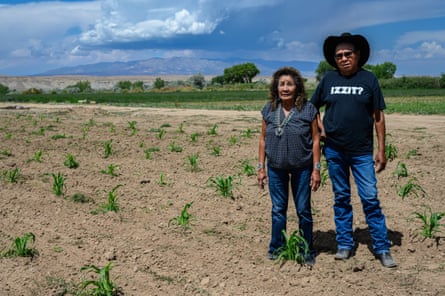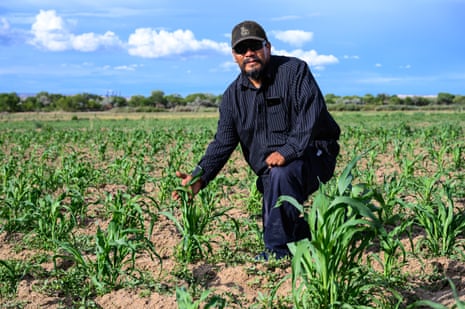On 7 August 2015, crews from the Navajo Nation irrigation office in Shiprock rushed to close the main gates of two irrigation canals that carry water from the San Juan River toward the fields of hundreds of Navajo farmers.
It was peak growing season in the arid north-western corner of New Mexico. About 12,000 acres of crops had been planted. And a disaster was threatening all of them.
Two days earlier, 115 miles upstream in Colorado, the Environmental Protection Agency (EPA) accidentally released about 3m gallons of acid mine water from the Gold King mine, during the initial stages of a cleanup operation. Spilling from Cement Creek into the Animas River and then the San Juan, the waterways – poisoned with nearly 540 tons of arsenic, lead, cadmium and other toxic metals – turned a sickly yellow.
“It was coming like a big flow of mustard,” recalled Shawn Mike, one of 222 Diné farmers and ranchers suing the EPA for their losses. The plume ultimately flowed more than 340 miles, coursing through tribal lands and three states to Lake Powell in southern Utah.
Seven years later, despite public promises to promote environmental justice for Indigenous communities and its admission of responsibility for the disaster, the EPA still refuses to compensate the farmers.
Though the agency has settled lawsuits with state and tribal governments for approximately $331m, the Department of Justice, which represents the EPA in court, asserts that individual Navajos – who together are asking for $49m – have no right to sue.
The impact of the spill hit the irrigators like a one-two punch. First, their crops died from a lack of water when the canals were closed. Then, once the farmers were growing again, they found their produce impossible to sell.
Mike pulls water from the Fruitland ditch, west of Farmington, on land first cultivated by his grandfather. When his fields dried up, he lost more than 10,000 corn plants, 1,000 squash plants and several acres of alfalfa.
“Corn is local farmers’ bread-and-butter,” he said. “It’s used in a variety of ways, for eating and traditional uses, so it has a high value. It was a catastrophe.” As the reality of their losses, both financial and cultural, began to sink in, “you could see tears in people’s eyes”.

Among those weeping was Bertha Etsitty, a 71-year-old farmer who with her husband, Allen, works about 20 acres near Shiprock. Their fields are fed by the Hogback ditch, and their views are framed by the silhouettes of distant peaks – Ute Mountain in Colorado, the Carrizos in Arizona, and Shiprock itself.
“Our corn was about 4ft tall when they closed the gates,” she said. “I knew we were going to lose it all. We even hauled water in and used cups to pour it for the plants. We saved a little of it, but …” she trailed off, leaving the tragic conclusion unspoken.
Thanks to the closing of the irrigation ditches, “no contamination reached the fields”, said Steve Austin, senior hydrologist with the Navajo Nation EPA. Within about three weeks the level of contaminants in the San Juan had diminished and the water was declared safe to use. Although the Fruitland canal reopened before the end of August, “many farmers didn’t trust it and wouldn’t use it”, Austin said. Irrigators on the Hogback canal voted to keep that ditch closed until the following spring.
When the 2016 harvest came in, farmers had trouble unloading it.
“People were afraid that the water was still contaminated,” said Allen Etsitty, “the way grease stays in the bottom of a pan”.
“We would try to sell our corn at flea markets and fairs, like in Gallup or Window Rock or Kayenta,” Bertha Etsitty elaborated. “But we had to haul most of it, and our melons, back home. A lot of people know I sell corn pollen [about two tablespoons of which go for $50], and I lost all of those customers. Our bills piled up. We fell behind on our truck payments, tractor payments, and one of our tractors, ‘Old Red,’ is now broken because we couldn’t afford to keep it maintained.”
Mike, who farms 10 miles upriver from the Etsittys, had a similar experience. “The water is ruined – to’ łitso – people said in Navajo.” His neighbor, Ernest Benally, who grows alfalfa on 12 acres, says that, even now, some people are still “skeptical of things grown around here. I sell to commercial beef growers, and they wouldn’t buy from me for a couple of years.”

Lawmakers are well aware of the losses that have been suffered. Among them, US congresswoman Teresa Leger Fernández says she has written to the DoJ urging it to settle the case and compensate the farmers. “They should do the right thing,” she said in a phone interview. “I want them to get restitution as quickly as possible, and the fastest way for that to happen is for it to come from the EPA.
“Justice delayed is justice denied,” she said, “and some of the plaintiffs have died since this lawsuit began. They’ll never see justice.”
Hózhó disrupted
Along with a well-earned mistrust of government information, many Navajos evaluated the lasting impact of the mine spill with criteria that went beyond measurable contaminant levels.
“The San Juan is a deity that Navajos revere,” said Karletta Chief, professor of environmental science and director of the Indigenous Resilience Center at the University of Arizona.
Navajo herself, she led research teams that assessed the environmental impact of the spill, communicated their findings to farmers, and tried to understand how the community perceived the risks posed to their health and way of life.

“Their connection to the world, their sense of balance in the world, is related to the river. So when the spill happened, that balance, that hózhó, was disrupted. Everything related to the river was also out of balance – it’s a complete system, all interconnected. Because the river was imbalanced, even the corn pollen was disrupted,” she said.
And that could have a negative impact on traditional ceremonies, even if samples showed no significant uptake in arsenic or lead in corn. “You can tell people that the water meets standards for drinking, for irrigating, but for people who are more spiritually connected, when is it OK to use it again?”
‘Drastic’ discharges
The basic facts in the case are not in dispute: the Gold King mine, in the mountains north of Silverton, Colorado, operated on and off between about 1887 and 1922. During that time, it produced more than 700,000 tons of gold and silver.
Fast-forward to the 1990s, when the sealing of the nearby Sunnyside mine redirected groundwater into Gold King. Though a cave-in blocked Gold King’s entrance, by the early 2000s, toxic water was leaking out in alarming amounts. It was “a drastic new high-quantity discharge … of extremely poor quality water, making this site one of the worst draining mines in the State of Colorado,” the state Division of Reclamation, Mining and Safety reported. It had to be cleaned up.
In 2015, after a few preliminary efforts, the EPA’s on-scene coordinator, Steve Way, approved a plan to drain the mine, created in consultation with an experienced independent contractor. Similar to an approach that had been successful at a neighboring mine, Gold King would be drilled into from above in order to figure out just how much water it contained, then pumped out in a safe and controlled manner. Only then would workers begin digging into the debris that was plugging the mine entrance, which dammed the water inside. Had this plan been followed, “the blowout would not have occurred,” the US Bureau of Reclamation concluded.
Instead, Way went on vacation. His temporary replacement, Hays Griswold, had no familiarity with Gold King before arriving at the site. Nevertheless, he quickly surveyed the scene and abandoned the work plan, concluding that what needed to be done “was very simple”, according to a sworn deposition. His decisions, which he said were based on a plan that he drew up in his head, directly led to the blowout.

The matter now before the US district court in New Mexico is not whether the EPA was responsible – it admits as much – but whether the Navajo farmers have a right to sue under the Federal Tort Claims Act. The latter allows individuals to sue federal agencies but also grants agencies broad immunities, particularly in situations “when an employee’s acts involve the exercise of judgment or choice”. The government asserts in court filings that Griswold exercised “just the type of discretionary, policy-based conduct” that is immune from tort claims. It is seeking to have the suit dismissed.
Kate Ferlic, the lead attorney for the plaintiffs, argues that immunity does not apply in this case, pointing out that the government isn’t shielded from lawsuits when employees violate policies that they are bound to follow. “Griswold was reckless and ended up poisoning a river system,” she said. “If immunity is granted under these circumstances, plans designed to protect public safety become meaningless.”
It would cost less for the EPA to compensate the farmers than to keep battling them in court, she said. “The government has spent more money on this case, in time and experts, than it would have taken to pay out all of the claims.”
It’s ‘just wrong’
Calvin Yazzie, a 71-year-old Navy veteran and former mine worker who lost alfalfa crops valued in the hundreds of thousands of dollars after the spill, said, “If you made a mistake and fessed up to it, you don’t need to try to swindle people and then smirk when you get away with it. It seems like that’s what the government is doing. To me, that’s just wrong.”
In principle, the EPA appears to agree. The agency says it has aligned with the Biden administration’s emphasis on advancing environmental justice for communities, “including people of color and others who have been historically underserved, marginalized, and adversely affected by poverty and inequality”. In an April 2021 memo outlining its environmental justice goals, one bullet point stands out: “Assist and seek to obtain restitution for victims of environmental crimes.”
When asked whether the government’s posture in the lawsuit contradicted the memo, the EPA replied by email that it is “committed to delivering environmental justice for underserved communities and overburdened communities, including Tribal nations”.
As the seventh anniversary of the spill approaches, the farmers are only seeing more delays. On 24 June, the trial date that had been set for early November was vacated and postponed for an indefinite period of time. It has not yet been rescheduled.
“We’re just waiting for some good news,” said a frustrated Ernest Benally, “but it’s going on and on and on”.
Standing beside him, Mike agreed. “We feel neglected, not heard, disrespected. We wish they would remember that we have a beating heart, also, and a lot of what it beats on is our farms, no matter how small.”
